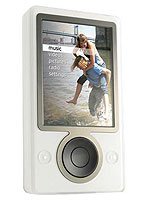There was a time when marketing executives were considered savvy, smart, or slick. Some probably are all those things, but not those involved with Microsoft’s new digital music player. Scott G takes a look at the marketing decisions for Zune (as in “rhymes with crazy as a loon”).
Remember when Microsoft unleashed its digital rights management scheme called PlaysForSure? Sounded like something designed for four-year-olds.
 You may also remember how we all watched it slowly die. I just did a search on Google using the term “PlaysForSure.” The first listing belongs to Microsoft’s official PFS site and it displays the following description: “Microsoft makes no representations or warranties regarding the products manufacturers make available on the PlaysForSure website.” That ForSure gives consumers a lot of confidence.
You may also remember how we all watched it slowly die. I just did a search on Google using the term “PlaysForSure.” The first listing belongs to Microsoft’s official PFS site and it displays the following description: “Microsoft makes no representations or warranties regarding the products manufacturers make available on the PlaysForSure website.” That ForSure gives consumers a lot of confidence.
Now Microsoft is back with a product they hope will be an iPod killer. It’s called Doom. No, wait, it’s called Dune. No, Zima. No, Zuma. No, Zune. Yeah, that’s it. Zune. As in “This product will probably be dead by next June.” Or as in “whoever is in charge of this is crazy as a loon.”
I doubt if Apple is too worried, but MS stockholders should be shaking their heads over this waste of time, energy and money. (MS reportedly has admitted that Zune will be unprofitable, just like their X-Box product.)
Pros & Cons
Let’s take a look at the Zune. The storage capacity and price are comparable to the iPod. The Zune’s screen is bigger, but the unit is bulkier which makes it feel kind of clunky.
A big plus according to MS is built-in Wi-Fi which will enable you to send a song to any other Zune player within 30 feet. Quite apart from the fact that I’d rather walk over to someone and strike up a conversation before plugging the two units together, there is also the rather annoying drawback that you reportedly lose one hour of battery life just for activating the feature. Photographer Snook comments, “They could put a string between two Zunes and talk to each other, if you turn up the volume on your larynx.”
Everyone who uses an iPod knows about the simplicity and elegance of the circular navigation control on the front panel. The Zune has one, too. Oops, no it doesn’t. The Zune actually has four buttons hidden under a circular panel cover.
Ah, I see an interesting marketing approach at work . . . make your product LOOK like your competitor’s but not function nearly as well. That allows you to cut down on cost, which you can pass on to consumers in the form of . . . the same price as your competitor.
Well, I’m not sure how that works, exactly, but I am confident that the geniuses at MS know what they’re doing.
Do The Math
Speaking of costs, let’s look at the song pricing on iTunes versus Zune. A song costs 99 cents on iTunes. A song costs 80 points on Zune.
What?
Eighty points. You don’t buy songs with Zune, you buy points and use them to purchase songs. Okay, so a song costs 80 points. That would be 80 cents, right? Wrong. It’s 99 cents.
What?
The reasoning here is that this process makes the Zune more “international.” Note to the rocket scientists at MS: Americans don’t like doing math under most circumstances and certainly not to figure out how much you’re charging for a digital download.
Paying Peter to Also Pay Paul
MS has also agreed to pay a dollar on the sale of each Zune to the world’s largest music corporation, Universal Music Group, in exchange for licensing their music for sale.
Wait. Say what? MS is making a device that will help record companies sell more songs, yet they have offered to pay extra on sales of the device itself? Interesting marketing move. So should we expect to see auto companies paying Exxon for every car they sell?
I have only seen the first two commercials for Zune, but I can tell you that I don’t care how good they might be (and they aren’t) because the overall marketing of the product is so flawed.
[tags]G-Man, Scott G, Communication Nation, advertising, marketing, ad rants, Microsoft, Apple, Zune, iPod[/tags]








